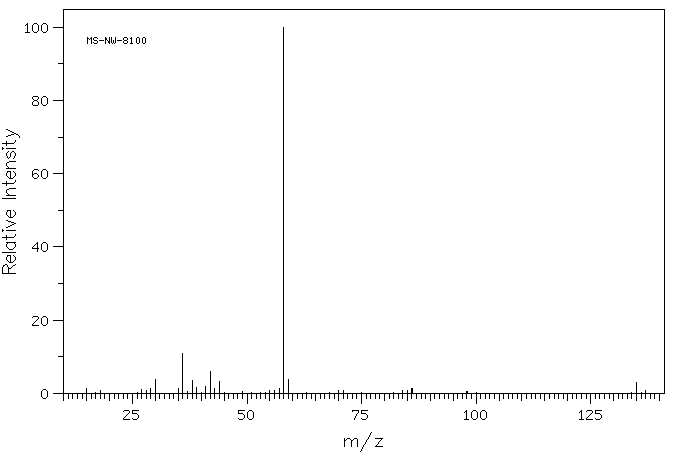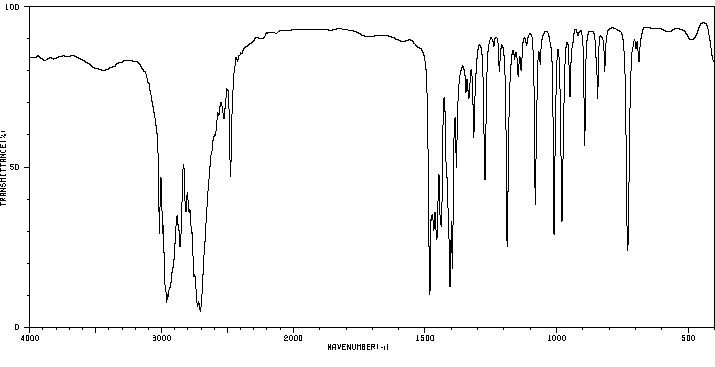3-二甲氨基-2-甲基-1-氯丙烷盐酸盐 | 4261-67-0
物质功能分类
中文名称
3-二甲氨基-2-甲基-1-氯丙烷盐酸盐
中文别名
3-二甲基氨基-2-甲基丙基氯盐酸盐;3-二甲基氨基-2-甲基丙基氯盐酸;N,N-二甲氨基-3-氯-2-甲基丙烷盐酸盐
英文名称
3-dimethylamino-2-methylpropyl chloride hydrochloride
英文别名
1-chloro-2-methyl-3-(dimethylamino)propane hydrochloride;3-Chloro-2-methyl-N,N-dimethylpropylamine hydrochloride;(3-chloro-2-methylpropyl)-dimethylazanium;chloride
CAS
4261-67-0
化学式
C6H14ClN*ClH
mdl
——
分子量
172.098
InChiKey
SOMIBONUMGNAEP-UHFFFAOYSA-N
BEILSTEIN
——
EINECS
——
-
物化性质
-
计算性质
-
ADMET
-
安全信息
-
SDS
-
制备方法与用途
-
上下游信息
-
文献信息
-
表征谱图
-
同类化合物
-
相关功能分类
-
相关结构分类
物化性质
-
熔点:169-173 °C
-
溶解度:氯仿(微溶)、甲醇(微溶)、水(微溶)
-
稳定性/保质期:
常温常压下稳定,为白色粉末或块状固体。
计算性质
-
辛醇/水分配系数(LogP):1.84
-
重原子数:9
-
可旋转键数:3
-
环数:0.0
-
sp3杂化的碳原子比例:1.0
-
拓扑面积:3.2
-
氢给体数:1
-
氢受体数:1
安全信息
-
危险品标志:Xi
-
危险类别码:R36/37/38
-
海关编码:2921199090
-
安全说明:S26,S37/39
-
危险性防范说明:P280,P305+P351+P338
-
危险性描述:H317,H319
-
储存条件:常温、避光、通风干燥处,密封保存。
SDS
| Name: | 3-Dimethylamino-2-Methylpropyl Chloride Hydrochloride 98% Material Safety Data Sheet |
| Synonym: | None known |
| CAS: | 4261-67-0 |
Synonym:None known
Section 2 - COMPOSITION, INFORMATION ON INGREDIENTS
| CAS# | Chemical Name | content | EINECS# |
| 4261-67-0 | 3-Dimethylamino-2-Methylpropyl Chlorid | 98 | 224-237-6 |
Risk Phrases: None Listed.
Section 3 - HAZARDS IDENTIFICATION
EMERGENCY OVERVIEW
The toxicological properties of this material have not been fully investigated.
Potential Health Effects
Eye:
May cause eye irritation.
Skin:
May cause skin irritation.
Ingestion:
May cause irritation of the digestive tract. The toxicological properties of this substance have not been fully investigated.
Inhalation:
May cause respiratory tract irritation. The toxicological properties of this substance have not been fully investigated.
Chronic:
No information found.
Section 4 - FIRST AID MEASURES
Eyes: Flush eyes with plenty of water for at least 15 minutes, occasionally lifting the upper and lower eyelids. Get medical aid.
Skin:
Get medical aid. Flush skin with plenty of water for at least 15 minutes while removing contaminated clothing and shoes. Wash clothing before reuse.
Ingestion:
Never give anything by mouth to an unconscious person. Get medical aid. Do NOT induce vomiting. If conscious and alert, rinse mouth and drink 2-4 cupfuls of milk or water.
Inhalation:
Remove from exposure and move to fresh air immediately. If not breathing, give artificial respiration. If breathing is difficult, give oxygen. Get medical aid.
Notes to Physician:
Section 5 - FIRE FIGHTING MEASURES
General Information:
As in any fire, wear a self-contained breathing apparatus in pressure-demand, MSHA/NIOSH (approved or equivalent), and full protective gear. During a fire, irritating and highly toxic gases may be generated by thermal decomposition or combustion.
Extinguishing Media:
Use agent most appropriate to extinguish fire. Use water spray, dry chemical, carbon dioxide, or appropriate foam.
Section 6 - ACCIDENTAL RELEASE MEASURES
General Information: Use proper personal protective equipment as indicated in Section 8.
Spills/Leaks:
Vacuum or sweep up material and place into a suitable disposal container. Clean up spills immediately, observing precautions in the Protective Equipment section. Avoid generating dusty conditions.
Provide ventilation.
Section 7 - HANDLING and STORAGE
Handling:
Wash thoroughly after handling. Remove contaminated clothing and wash before reuse. Use with adequate ventilation. Minimize dust generation and accumulation. Avoid contact with eyes, skin, and clothing. Keep container tightly closed. Avoid ingestion and inhalation.
Storage:
Store in a tightly closed container. Store in a cool, dry, well-ventilated area away from incompatible substances.
Section 8 - EXPOSURE CONTROLS, PERSONAL PROTECTION
Engineering Controls:
Facilities storing or utilizing this material should be equipped with an eyewash facility and a safety shower. Use adequate ventilation to keep airborne concentrations low.
Exposure Limits CAS# 4261-67-0: Personal Protective Equipment Eyes: Wear appropriate protective eyeglasses or chemical safety goggles as described by OSHA's eye and face protection regulations in 29 CFR 1910.133 or European Standard EN166.
Skin:
Wear appropriate protective gloves to prevent skin exposure.
Clothing:
Wear appropriate protective clothing to prevent skin exposure.
Respirators:
A respiratory protection program that meets OSHA's 29 CFR 1910.134 and ANSI Z88.2 requirements or European Standard EN 149 must be followed whenever workplace conditions warrant respirator use.
Section 9 - PHYSICAL AND CHEMICAL PROPERTIES
Physical State: Powder
Color: off-white
Odor: none reported
pH: Not available.
Vapor Pressure: Not available.
Viscosity: Not available.
Boiling Point: Not available.
Freezing/Melting Point: 167.00 - 170.00 deg C
Autoignition Temperature: Not applicable.
Flash Point: Not applicable.
Explosion Limits, lower: Not available.
Explosion Limits, upper: Not available.
Decomposition Temperature:
Solubility in water:
Specific Gravity/Density:
Molecular Formula: C6H14ClN.HCl
Molecular Weight: 172.10
Section 10 - STABILITY AND REACTIVITY
Chemical Stability:
Stable under normal temperatures and pressures.
Conditions to Avoid:
Incompatible materials, dust generation, excess heat, strong oxidants.
Incompatibilities with Other Materials:
Oxidizing agents.
Hazardous Decomposition Products:
Hydrogen chloride, nitrogen oxides, carbon monoxide, irritating and toxic fumes and gases, carbon dioxide.
Hazardous Polymerization: Has not been reported
Section 11 - TOXICOLOGICAL INFORMATION
RTECS#:
CAS# 4261-67-0 unlisted.
LD50/LC50:
Not available.
Carcinogenicity:
3-Dimethylamino-2-Methylpropyl Chloride Hydrochloride - Not listed by ACGIH, IARC, or NTP.
Section 12 - ECOLOGICAL INFORMATION
Section 13 - DISPOSAL CONSIDERATIONS
Dispose of in a manner consistent with federal, state, and local regulations.
Section 14 - TRANSPORT INFORMATION
IATA
Not regulated as a hazardous material.
IMO
Not regulated as a hazardous material.
RID/ADR
Not regulated as a hazardous material.
Section 15 - REGULATORY INFORMATION
European/International Regulations
European Labeling in Accordance with EC Directives
Hazard Symbols: Not available.
Risk Phrases:
Safety Phrases:
S 24/25 Avoid contact with skin and eyes.
S 28A After contact with skin, wash immediately with
plenty of water.
S 37 Wear suitable gloves.
S 45 In case of accident or if you feel unwell, seek
medical advice immediately (show the label where
possible).
WGK (Water Danger/Protection)
CAS# 4261-67-0: No information available.
Canada
None of the chemicals in this product are listed on the DSL/NDSL list.
CAS# 4261-67-0 is not listed on Canada's Ingredient Disclosure List.
US FEDERAL
TSCA
CAS# 4261-67-0 is not listed on the TSCA inventory.
It is for research and development use only.
SECTION 16 - ADDITIONAL INFORMATION
N/A
制备方法与用途
用途:用于制作医药中间体
反应信息
-
作为反应物:描述:参考文献:名称:THIN-FILM FORMING RAW MATERIAL FOR USE IN ATOMIC LAYER DEPOSITION METHOD, THIN-FILM FORMING RAW MATERIAL, METHOD FOR PRODUCING THIN-FILM, AND COMPOUND摘要:本发明提供了一种薄膜形成原料,用于原子层沉积方法,包括由以下一般式(1)表示的化合物:其中R1至R4分别独立表示具有1至5个碳原子的烷基基团,A1表示具有1至5个碳原子的烷二基基团。公开号:US20210340162A1
-
作为产物:描述:参考文献:名称:侧链对叔胺官能化多肽的pH和热响应性的影响摘要:侧链上的pH的结构影响的系统调查和叔胺官能化聚(热响应性升-谷氨酸)S(TA-的PGs)中的溶液中进行。通过铜(I)催化的叠氮基叔胺与聚(γ-炔丙基-l-谷氨酸)(PPLG)的叠氮化物-炔烃环加成点击反应有效合成了TA-PGs聚合物。进行了比浊法测量,以表征TA-PG在水溶液中的pH和温度诱导的相变,这表明该性质对氮的结构依赖性取代基团和1,2,3-三唑环与侧链中叔胺基团之间的“连接基”。详细地讲,TA-PG的pH响应特性基本上由侧链中N-取代基团的疏水性决定,pH转变点(pH t)随着N-取代基团疏水性的增加而降低,而TA PG的温度响应性受N取代基或“连接基”的影响。具有中等N取代胺基(例如DEA,PR和PD)或支链“连接子”(例如iso-丙烯和2-甲基丙烯基)更可能表达因pH值变化而调整的LCST型相变。这项研究揭示的这些结构-属性关系将有助于开发TA-PG在智能药物输送系统中的应用。©2013DOI:10.1002/pola.27048
文献信息
-
6-Substituted 9-fluoroquino[3,2-b]benzo[1,4]thiazines display strong antiproliferative and antitumor properties作者:Małgorzata Jeleń、Krystian Pluta、Michał Zimecki、Beata Morak-Młodawska、Jolanta Artym、Maja KociębaDOI:10.1016/j.ejmech.2014.10.070日期:2015.16-Substituted 9-fluoroquino[3,2-b]benzo[1,4]thiazines – a new type of tetracyclic azaphenothiazines–were obtained from of 6H-9-fluoroquinobenzothiazine by the introduction of appropriate substituents to the thiazine nitrogen atom (alkyl, aminoalkyl, amidoalkyl, sulfonamidoalkyl and nitrogen half-mustard groups). The compounds displayed differential cytotoxic as well as antiproliferative actions against通过在噻嗪氮原子上引入适当的取代基,从6 H -9-氟喹啉苯并噻嗪制得6-取代的9-氟喹啉[3,2-b]苯并[1,4]噻嗪(一种新型的四环氮杂噻嗪)。烷基,氨基烷基,酰胺基烷基,磺酰胺基烷基和氮半芥子基团)。这些化合物对植物血凝素A(PHA)刺激的人外周血单核细胞(PBMC)表现出不同的细胞毒性和抗增殖作用。此外,他们抑制了全血人细胞培养物中脂多糖(LPS)诱导的肿瘤坏死因子α(TNF-α)的产生。两种化合物(4和15由于缺乏细胞毒性和强大的抗增殖作用,因此选择具有炔丙基和甲磺酰胺基丙基的化合物进行进一步实验。化合物4对L1210,SW948,A-431和CX-1肿瘤细胞系的生长表现出强大的抑制作用,与参考药物顺铂相似(例如GI 50为2.28μg/ mL,与。对于L1210细胞为1.86μg/ mL)。此外,该化合物似乎在抑制人双向混合淋巴细胞反应(MLR)中与环孢菌素A(CsA)同
-
一种具有还原性的可聚合表面活性剂及其制 备方法申请人:常州大学公开号:CN111302960B公开(公告)日:2021-06-22
-
Synthesis of 6-Aminoalkyldiquino-1,4-thiazines and Their Acyl and Sulfonyl Derivatives作者:Krystian Pluta、Malgorzata JelenDOI:10.3987/com-07-11269日期:——primary amines, and 6H-diquino-1,4-thiazine (4) with dialkylaminoalkyl chlorides and phthalimidoalkyl bromides followed by hydrolysis. 6-Aminoalkyldiquinothiazines (11-13) were transformed into acyl and sulfonyl derivatives (15-26). Some of the obtained compounds showed significant anticancer activity.
-
AZACARBOLINE DERIVATIVES, PREPARATION METHOD THEREOF AND THERAPEUTIC USE OF SAME申请人:Arendt Christopher公开号:US20110178053A1公开(公告)日:2011-07-21The invention relates to novel azacarbonlines having formula (I), wherein: R3, R4 represent independently H; hal; CF 3 ; substituted oxy, optionally substituted alkoxy; optionally substituted amino; substituted carbonyl; optionally substituted carboxyl; optionally substituted amide; sulphur, such as optionally substituted sulphones, sulphoxides or sulphides; linear, branched or cyclic C 1 -C 10 alkyl optionally comprising an optionally substituted heteroatom; optionally substituted linear, branched or cyclic C 2 -C 7 alkenyl; optionally substituted linear or branched C 2 -C 6 alkynyl; optionally substituted aryl or heteroaryl; of which may be optionally substituted; in the form of a base or an acid addition salt. The invention also relates to the use of same in therapeutics for the treatment of cancer and to synthesis methods.
-
Synthesis of Novel Dipyrido-1,4-thiazines作者:Krystian Pluta、Beata Morak-MlodawskaDOI:10.3987/com-07-11035日期:——An efficient synthesis of novel type of dipyrido-1,4-thiazine (4) was elaborated in the reactions of two pairs of 3,4-disubstituted pyridines in DMF. The reactions proceeded through the S→N type of the Smiles rearrangement of the resulting 4,4'-dipyridinyl sulfide. In the case of formation of 10-(3'-nitro-4'- pyridinyl)-2,7-diazaphenothiazine (5) double rearrangement was observed. 10H- 2,7-diazaphenothiazine通过两对 3,4-二取代吡啶在 DMF 中的反应,详细阐述了新型双吡啶-1,4-噻嗪 (4) 的有效合成方法。反应通过生成的 4,4'-联吡啶硫醚的 S→N 型 Smiles 重排进行。在形成 10-(3'-nitro-4'-pyridinyl)-2,7-二氮杂吩噻嗪 (5) 的情况下,观察到双重排。10H-2,7-二氮杂吩噻嗪(4)被N-烷基化、N-芳基化和N-杂芳基化以得到10-取代的(烷基、芳基烷基、芳基、杂芳基和二烷基氨基烷基)衍生物(5)和(17-29)。NMR光谱是在甲基衍生物的1 H- 1 H相关性(COSY)和NOE实验(17)的帮助下确定的。关键的 10H-2,7-二氮杂吩噻嗪 (4) 显示出有希望的抗癌活性。
表征谱图
-
氢谱1HNMR
-
质谱MS
-
碳谱13CNMR
-
红外IR
-
拉曼Raman
-
峰位数据
-
峰位匹配
-
表征信息
同类化合物
(乙腈)二氯镍(II)
(R)-(-)-α-甲基组胺二氢溴化物
(N-(2-甲基丙-2-烯-1-基)乙烷-1,2-二胺)
(4-(苄氧基)-2-(哌啶-1-基)吡啶咪丁-5-基)硼酸
(11-巯基十一烷基)-,,-三甲基溴化铵
鼠立死
鹿花菌素
鲸蜡醇硫酸酯DEA盐
鲸蜡硬脂基二甲基氯化铵
鲸蜡基胺氢氟酸盐
鲸蜡基二甲胺盐酸盐
高苯丙氨醇
高箱鲀毒素
高氯酸5-(二甲氨基)-1-({(E)-[4-(二甲氨基)苯基]甲亚基}氨基)-2-甲基吡啶正离子
高氯酸2-氯-1-({(E)-[4-(二甲氨基)苯基]甲亚基}氨基)-6-甲基吡啶正离子
高氯酸2-(丙烯酰基氧基)-N,N,N-三甲基乙铵
马诺地尔
马来酸氢十八烷酯
马来酸噻吗洛尔EP杂质C
马来酸噻吗洛尔
马来酸倍他司汀
顺式环己烷-1,3-二胺盐酸盐
顺式氯化锆二乙腈
顺式吡咯烷-3,4-二醇盐酸盐
顺式双(3-甲氧基丙腈)二氯铂(II)
顺式3,4-二氟吡咯烷盐酸盐
顺式1-甲基环丙烷1,2-二腈
顺式-二氯-反式-二乙酸-氨-环己胺合铂
顺式-二抗坏血酸(外消旋-1,2-二氨基环己烷)铂(II)水合物
顺式-N,2-二甲基环己胺
顺式-4-甲氧基-环己胺盐酸盐
顺式-4-环己烯-1.2-二胺
顺式-4-氨基-2,2,2-三氟乙酸环己酯
顺式-3-氨基环丁烷甲腈盐酸盐
顺式-2-羟基甲基-1-甲基-1-环己胺
顺式-2-甲基环己胺
顺式-2-(苯基氨基)环己醇
顺式-2-(苯基氨基)环己醇
顺式-2-(氨基甲基)-1-苯基环丙烷羧酸盐酸盐
顺式-1,3-二氨基环戊烷
顺式-1,2-环戊烷二胺二盐酸盐
顺式-1,2-环戊烷二胺
顺式-1,2-环丁腈
顺式-1,2-双氨甲基环己烷
顺式--N,N'-二甲基-1,2-环己二胺
顺式-(R,S)-1,2-二氨基环己烷铂硫酸盐
顺式-(2-氨基-环戊基)-甲醇
顺-2-戊烯腈
顺-1,3-环己烷二胺
顺-1,3-双(氨甲基)环己烷








